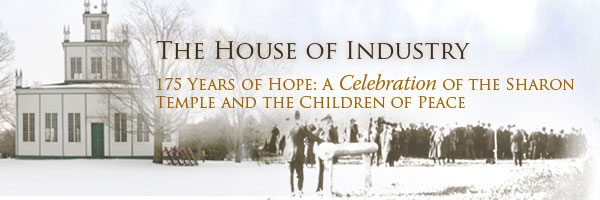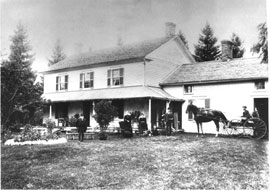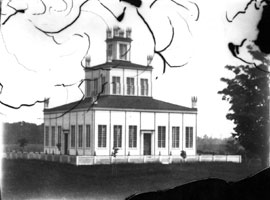
Table of Contents

Click to see a larger image (136K)
Walnut farm, the home of prosperous Children of Peace member,
Judah Lundy and his family.
Sharon Temple Museum Archives
The Children of Peace built a House of Affliction in Hope sometime before 1832, which administered relief according to the principles of “Christian charity.”
This shelter must be viewed in the context of their local economic system, geared as it was to helping members maintain their economic and political independence. All the poor were housed and fed when in need, but those the Lt. Governor considered the “undeserving poor,” the able-bodied unemployed, were then provided with the means of achieving their economic independence.
The Children of Peace were not communal, but through land sharing, co-operative marketing and their credit union, spurred members to individual achievement.
These economic innovations were developed to address poverty’s root cause. Their co-operative economy proved so successful that by 1851, when the first complete census is available, Hope was the most prosperous community in Ontario.

This glass negative photograph is the oldest known
image of the Sharon Temple
Sharon Temple Museum Archives
We can contrast the House of Affliction they built with the House of Industry proposed by Sir Francis Bond Head, a former Assistant Poor Law Commissioner, and the province’s first civilian Lt. Governor. The Poor Law Amendment Act had been the product of a lengthy and rancorous debate on the most appropriate means of relieving the English poor.
The House of Industry was based on the principal that the conditions within it should always be worse than the worst conditions outside its walls to discourage people from seeking welfare there.
These were the workhouses described by Dickens in David Copperfield. To create these Houses of Industry here, Bond Head passed legislation in 1837 in the midst of a widespread depression which empowered any two magistrates to indefinitely jail any unemployed worker in one.
It is only by placing their economic system in context that we can come to understand why the Children of Peace devoted so much of their efforts to constructing their ornate and expensive temple;
this building symbolized their aim to “to sacrifice to God, feed the hungry, and clothe the naked.” - From an untitled pamphlet by David Willson, quoted in manuscript, (Archives of Ontario: Ms 188, June 24, 1831.)
Under continual legal and political attack by the province’s elite, they justified their co-operative economy in religious terms. In building the Temple they demonstrated to their neighbours that they were God’s chosen people, and that their alternative values had sacred legitimacy.
Giving to the poor was not a simple economic act to be regulated by poor laws, but a moral requirement mandated by God. It is this moral mandate that moved reformers like them to create the Farmers Store House, and the Bank of the People. In each case, reformers sought to create a specific kind of economic institution to address the problems of debt; and the poor thereby found themselves participating in institutions that fostered oppositional democratic values and skills.